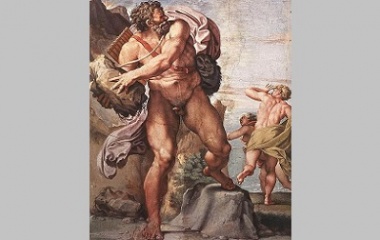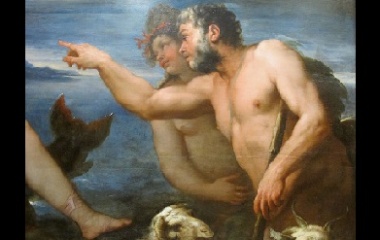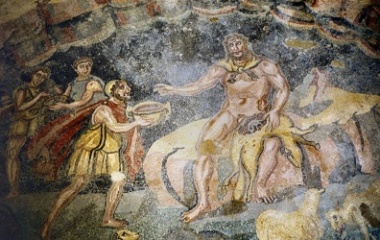- Pronunciation: pa-LEE-fe-mes
- Origin: Greek
- Role: Cyclops
- Symbols: Wine, Sheep
- Children: Galatos
- Habitat: Sicily
Who Is Polyphemus?
Polyphemus was the son of Poseidon. His mother was Thoosa. He was a giant and one of the Cyclopes featured in Greek mythology. The myths surrounding him are often contradictory, with some portraying him as an evil monster while others show a less aggressive side of the giant. He played a main role in the journey of Odysseus.
Origins
Polyphemus’ myth was a widespread story. It is one of the better-known tales that appeared in Book 9 of Homer’s Odyssey. The story of the cyclopes is still beloved today as it inspires the imagination and seems to represent the essence of mythology.
Legends and Stories
The story of the Odyssey says that Odysseus landed on the island of Cyclops (modern day Sicily) while attempting to navigate his way back to his homeland Ithaca. While exploring the island, he and his men entered a cave that was stocked with delicious food. What they didn’t realize was that it was the cave of Polyphemus and they were eating his stock. He was out on the island, tending to his flock of sheep, and returned to find the men.
He was enraged, led his sheep into the cave, blocked the entrance with a large stone and immediately grabbed two of the men, smashed their heads against the rocky walls and ate them. He went to sleep, leaving Odysseus and his men terrified. When the giant awoke, he immediately ate two more men, removed the stone, led his sheep out and then trapped the men inside again. While he was gone, Odysseus began to devise a plan.
When Polyphemus returned to the cave, Odysseus offered the giant some strong wine. Polyphemus became intoxicated and while he was drunk, he asked Odysseus what his name was. He replied, “No one.” Satisfied with the answer, Polyphemus told Odysseus that he would eat “No one” last to show his gratitude for the drink. He then fell into a deep sleep.
Odysseus seized the opportunity and took a wooden stake that he had carved while the giant had left him earlier in the day. He put it into the center of a hot fire, waiting until it glowed bright red with intense heat. He drove it straight into the giant’s eye and it blinded him instantly. Polyphemus began to scream, begging the other giants on the island to help him. As they arrived, he told them that “No one” had done this to him. This saved Odysseus, who eventually escaped the cave. The other giants assumed that a god had attacked Polyphemus and told him to pray for help, as they couldn’t interfere.
In the morning, Polyphemus still had to tend to his sheep. He let them out of the cave to eat but because he was unable to see, he felt the back of the sheep, wondering if any of the men who had still been trapped in the cave were riding on them. He felt nothing and went about his day as best as he could without being able to see.
But Odysseus was wise and had told his men to tie themselves underneath the bellies of the animals. This allowed them to escape, reach their ship and sail away. As the ship reached farther away from the land, Odysseus decided to tell the giant his real name. This was a mistake though because Polyphemus asked his father to seek revenge on the man who had taken his sight.
Family
Polyphemus’ parents were both well-known mythological figures. He also married and had anywhere from one to four children, depending on the source.
Poseidon
Poseidon, the father of Polyphemus, was one of the most popular gods in Greek mythology. His father was Cronus and his brothers were Zeus and Hades. He was the god of the sea and widely worshipped by those who traveled on the open water. He was also the protector of all aquatic features.
Thoosa
Thoosa, a sea nymph, had an affair with Poseidon and gave birth to Polyphemus. She was known for creating dangerously swift currents in the oceans and was described as being a mermaid-like creature. Instead of legs, she had the tail of a fish but her upper half resembled a human.
Lover and Children
Legends say that Polyphemus fell in love with Galatea, a sea nymph. Some indicate that his love for her went unnoticed, while others say that his courtship was successful. In a dialogue of Lucian of Samosata, we learn that Doris, a sister of Galatea, was jealous of her sister’s happy love story. Galatea admits to her that she doesn’t really love the giant but instead entered the relationship as she enjoyed being the one that he chose.
Again, sources are a bit contradictory but it is said that Polyphemus and Galatea had a son named Galatos. Others say that they had three children, Galas, Celtus and Illyruis. All sources say that from their offspring, the Celts descended.
There is another story that tells the later years of Polyphemus’ relationship with Galatea. Because she did not really love the giant, she has an affair with Acis. Polyphemus catches them and crushes Acis with a rock in a fit of rage. Galatea flees but returns to transform Acis’ spirit into the spirit of the Sicilian river.
Appearance
According to artistic depictions of Polyphemus, he was a giant and a cyclops. He towered over mortals and while he had two eye sockets like man, they were empty. He then had a single eye in the center of his forehead. Most depictions of him show him as a terrifying monster. In some pictures, he is chasing his human prey while other show him eating them. There are also many pictures showing his softer side and relationship with Galatea, his lover and mother of his children.
Symbology
Cyclopes in general are associated with their single eye. Polyphemus is no different and he is also associated with his blindness. Cyclopes were considered to be wild creatures that because of their size lived above the laws of the gods and the guidelines of community.










